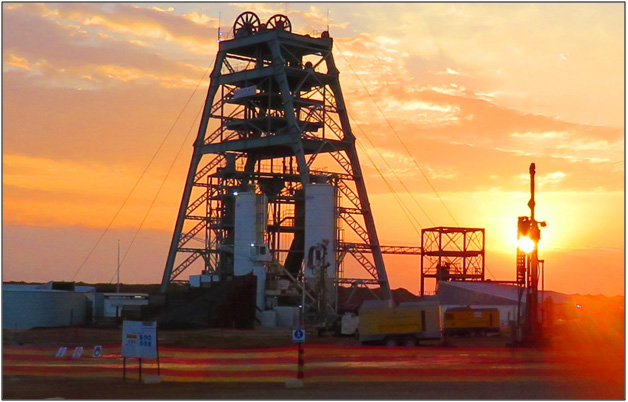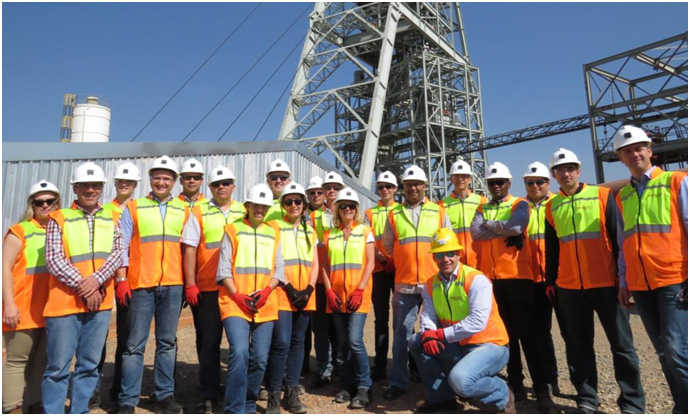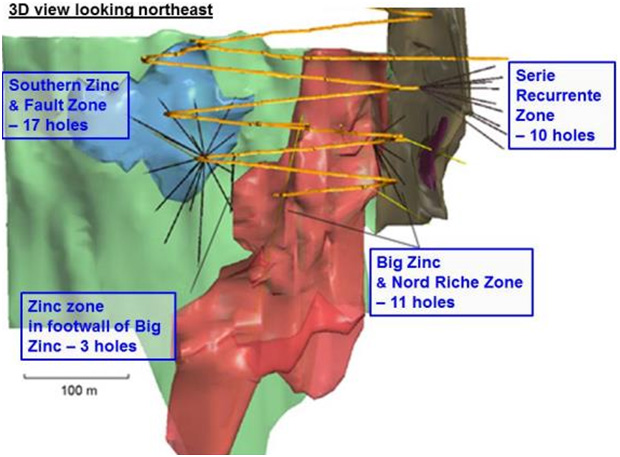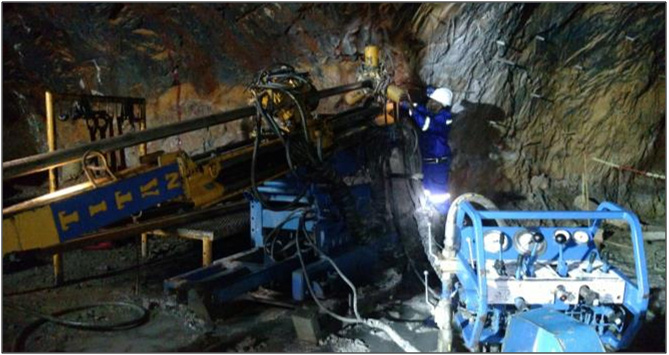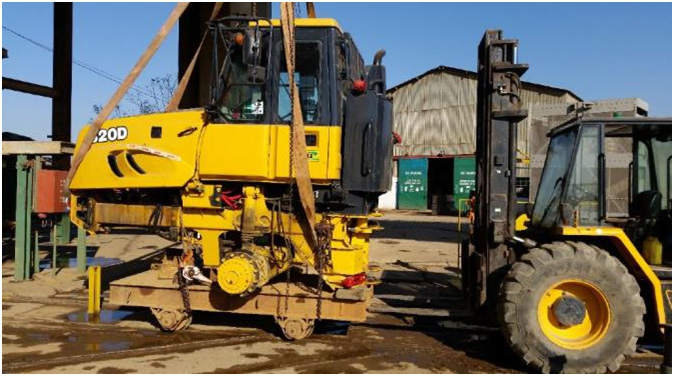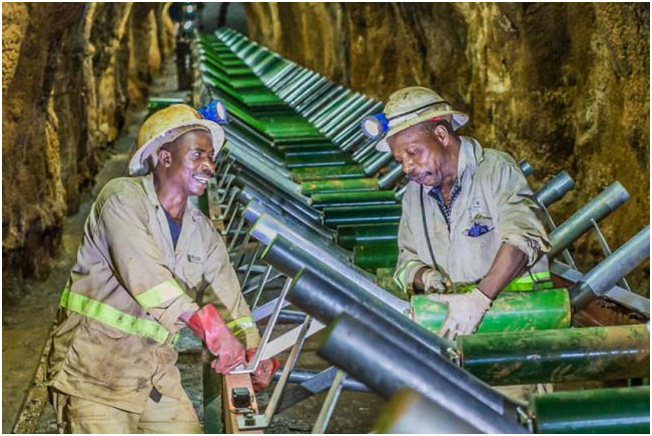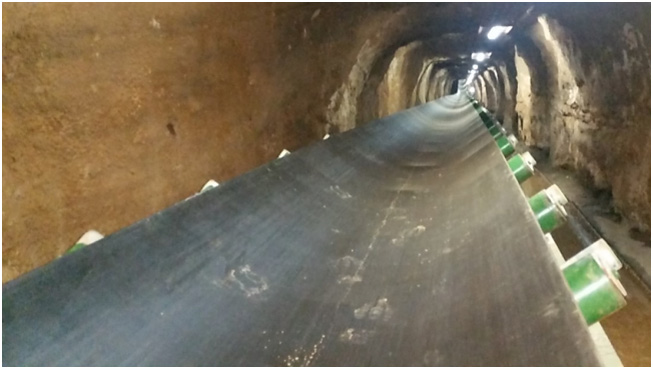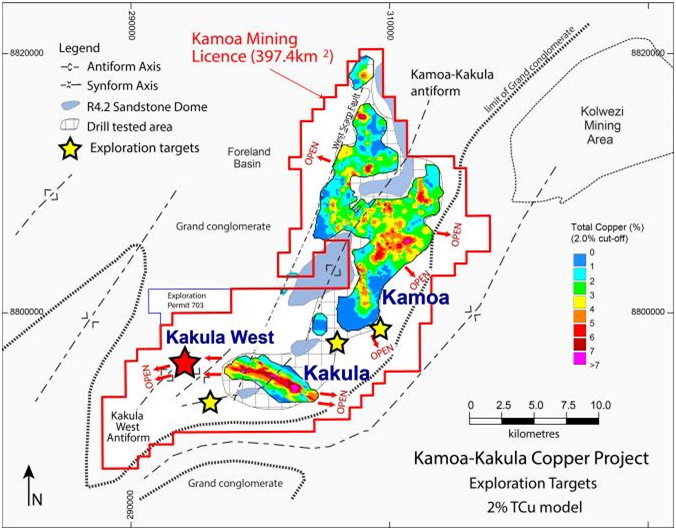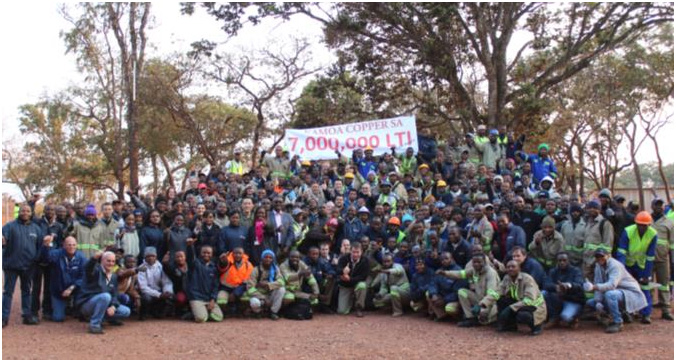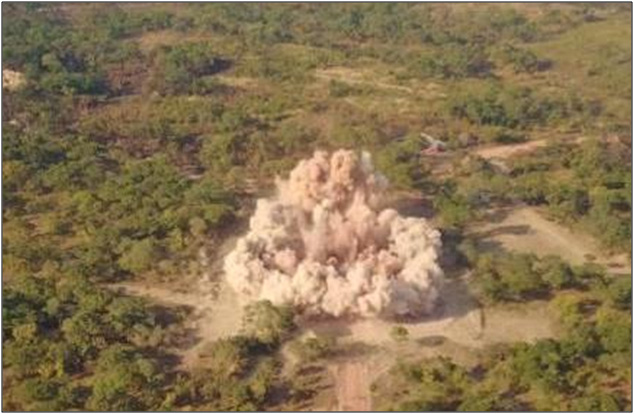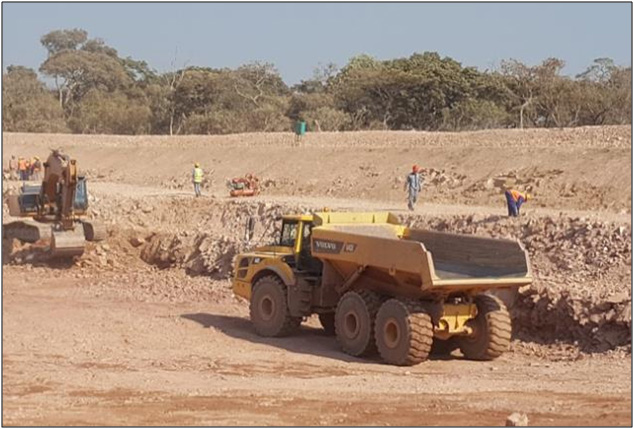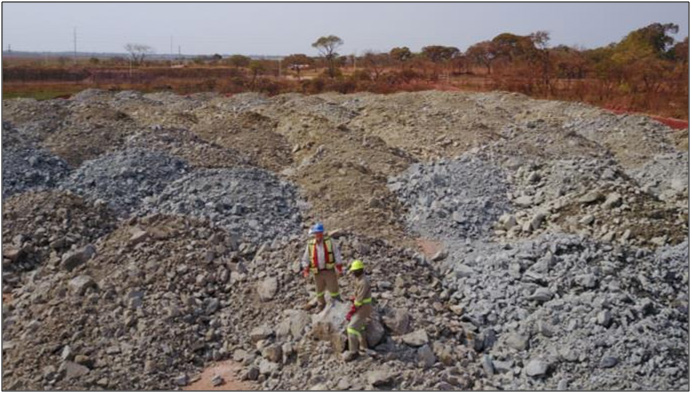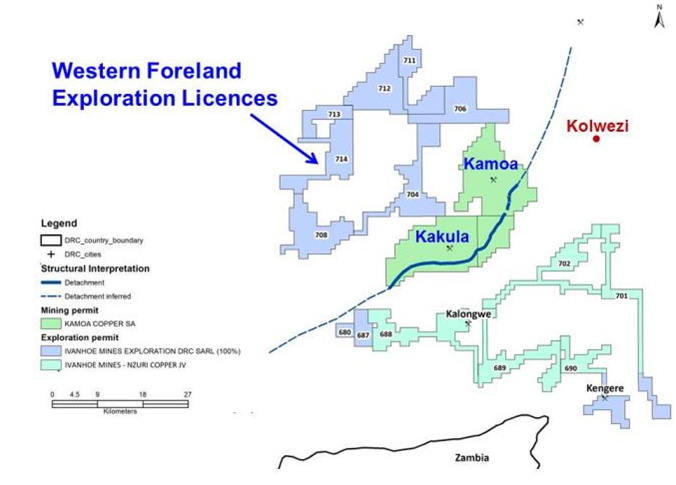Updated Mineral Resource estimate in May boosts tonnage
of the Kakula Discovery’s Indicated Resources
by 75% to 116 million tonnes at 6.09% copper,
and combined Indicated Resources at Kamoa-Kakula
to approximately one billion tonnes at 3.02% copper
Start of mine development work at Kakula Discovery
highlights another busy quarter at Ivanhoe’s
three mine development projects in Southern Africa
TORONTO, CANADA ‒ Ivanhoe Mines (TSX: IVN; OTCQX: IVPAF) today announced its financial results for the second quarter ended June 30, 2017. All figures are in U.S. dollars unless otherwise stated. Ivanhoe Mines is a Canadian mining company focused on advancing its three mine-development projects in Southern Africa: the Platreef platinum-palladium-gold-nickel-copper discovery in South Africa; and the Kamoa-Kakula copper discovery and the Kipushi zinc-copper-silver-germanium mine in the Democratic Republic of Congo (DRC).
HIGHLIGHTS
- On May 17, 2017, Ivanhoe issued an updated resource estimate showing that the Kakula Discovery at the Kamoa-Kakula Project contains Indicated Mineral Resources of 116 million tonnes at 6.09% copper, plus Inferred Resources of 12 million tonnes at 4.45% copper, at a 3% cut-off. Kakula’s new estimate boosts combined Indicated Mineral Resources at both the Kamoa and Kakula discoveries to approximately one billion tonnes at 3.02% copper, plus another 191 million tonnes of Inferred Resources at 2.37% copper, at a 1.4% cut-off.
- The May 2017 Kakula estimate establishes the Kamoa-Kakula Project in the ranks of the five largest copper deposits in the world. The project’s copper grades are the highest, by a wide margin, of the world’s top 10 copper deposits. Both the subsequent Kakula Discovery and the original Kamoa Discovery continue to remain open for significant expansion.
- In late June, excavation began on the surface box cut at the Kakula Discovery. The box cut will be excavated to a depth of approximately 18 metres below surface and is expected to be completed in October. Construction of twin declines, similar to those at Kamoa’s Kansoko Mine, will begin once construction of the box cut has been completed.
- Kamoa Copper has retained OreWin Pty. Ltd., of Australia, to prepare a follow-up preliminary economic assessment (PEA) for the development of the Kakula and Kamoa deposits. It is expected that the increased resource base at Kakula will support a mine capacity of approximately six million tonnes per annum (Mtpa). The capacity of the Kansoko Mine also is expected to be six Mtpa, giving the revised PEA a projected peak mine production of approximately 12 Mtpa from the presently delineated Kamoa and Kakula deposits. In light of the successful step-out drilling at Kakula West, as well as the potential to find additional resources in high-priority targets located in the untested parts of the Kamoa-Kakula Project area, the Kamoa-Kakula development plans will be reassessed and amended as the project moves forward.
- Drill intercepts rich in chalcocite and bornite continue to be returned at Kakula West and in the saddle area between the Kakula Mineral Resource area and the Kakula West discovery area. Drilling now has extended the strike length of the Kakula West copper-rich mineralized system to approximately 2.9 kilometres, and the high-grade Kakula mineralized system to more than 12 kilometres.
- Ivanhoe expects to issue a comprehensive drilling update for the Kakula Discovery in early September, which will include assays received since the May 2017 resource estimate. An updated Mineral Resource estimate for the entire 12-kilometre-long Kakula mineralized system defined to date, including the Kakula West Discovery, is expected before the end of the year.
- The Kakula Discovery remains open for significant expansion along trend to the west and the southeast, while the remainder of the Kakula Exploration Area remains virtually untested. More than 68,000 metres have been drilled at Kakula since the start of the year. A total of 14 rigs are drilling at the Kamoa-Kakula Project.
- Nearly 200 square kilometres of the approximately 400-square-kilometre Kamoa-Kakula Project area remain untested. The Kamoa-Kakula geology team, with the assistance of technical advisors, has intensively evaluated the structural and stratigraphic controls on mineralization of the broader Kamoa-Kakula basin. This work has highlighted at least nine high-priority targets located in untested portions of the Kamoa-Kakula mining licence. Drill testing of two of the targets — Kamoa Ouest (West) and Makalu/Kakula NE — is underway.
- Ivanhoe holds an extensive, 100%-owned exploration land position in the Western Foreland region, just to the west of the Kamoa-Kakula mining licence, which is highly prospective for Kamoa-Kakula-type copper discoveries. Ivanhoe’s DRC exploration team has begun an initial, $4 million exploration program on the Western Foreland licences.
- Underground development at Kamoa’s Kansoko Mine, consisting of service and conveyor declines, made excellent progress in Q2 and mining of the high-grade copper ore began in July. Decline development work at Kansoko is expected to be completed by September.
- On July 31, Ivanhoe announced the positive results of an independent definitive feasibility study for the planned first phase of its Platreef platinum-group elements, nickel, copper and gold mine in South Africa. The study envisages an initial annual throughput rate of four million tonnes a year, producing 476,000 ounces of platinum, palladium, rhodium and gold (3PE+Au), plus 33 million pounds of nickel and copper.
- The Platreef Mine is projected to be Africa’s lowest-cost producer of platinum-group metals, with a cash cost of $351 per ounce of 3PE+Au, net of by-products, including sustaining capital cost. There is good potential for relatively quick and capital-efficient expansion to six and eight million tonnes a year, and beyond, using start-up infrastructure.
- Ivanhoe now has appointed five leading mine-financing institutions as Initial Mandated Lead Arrangers to arrange debt financing for the development of the Platreef Mine. They are: KfW IPEX-Bank, a German government owned institution; Swedish Export Credit Corporation; Export Development Canada; Nedbank Limited (acting through its Corporate and Investment Banking division); and Societe Generale Corporate & Investment Banking. Expressions of interest have been received for approximately $900 million of the targeted $1 billion project financing. Discussions have begun around the financing of the broad-based, black economic empowerment structure. Strategic discussions regarding the Platreef Project also are continuing with significant global mining companies and investors.
- Sinking of Platreef’s Shaft 1 has reached a depth of 451 metres below surface and development of the first of four planned shaft stations – the 450-metre-level substation – is underway. Shaft 1 is expected to reach the Flatreef Deposit, at a depth of 777 metres below surface, in the first half of 2018. Sinking will continue to a planned final depth of 980 metres below surface.
- Early-works construction for Platreef’s Shaft 2 began in April 2017. Construction will consist of excavation of a box cut to a depth of approximately 29 metres below surface and construction of the concrete hitch (foundation) for the 103-metre-tall concrete headgear (headframe) that will house the shaft’s permanent hoisting facilities and support the shaft collar.
- A 6,500-metre drilling program at Kipushi is underway. The program includes six metallurgical holes in the Big Zinc Deposit and resource drilling in the Fault Zone, the Nord Riche and Southern Zinc zones to expand and upgrade Inferred Resources.
- A pre-feasibility study for the redevelopment of the Kipushi zinc-copper-germanium-lead-silver mine is being prepared by OreWin, of Australia. The comprehensive study is progressing and will refine Ivanhoe’s May 2016 preliminary economic assessment of Kipushi’s proposed redevelopment.
- Ivanhoe Mines’ three projects achieved a combined 12.3 million work hours free of lost-time injuries (LTIF) by the end of Q2 2017. Ivanhoe had recorded almost 43,000 LTIF hours at Platreef, 5.5 million hours at Kipushi and more than 6.8 million hours at Kamoa-Kakula to the end of Q2 2017.
Principal projects and review of activities
1. Platreef Project
64%-owned by Ivanhoe Mines
South Africa
The Platreef Project is owned by Ivanplats (Pty) Ltd, which is 64%-owned by Ivanhoe Mines. A 26% interest is held by Ivanplats’ historically-disadvantaged, broad-based, black economic empowerment (B-BBEE) partners, which include 20 local host communities with a total of approximately 150,000 people, project employees and local entrepreneurs.In January 2017,Ivanplats reconfirmed its Level 3 status in its third verification assessment on a B-BBEE scorecard. A Japanese consortium of ITOCHU Corporation, Japan Oil, Gas and Metals National Corporation and Japan Gas Corporation owns a 10% interest in Ivanplats, which it acquired in two tranches for a total investment of $290 million.
The Platreef Project hosts an underground deposit of thick, platinum-group metals, nickel, copper and gold mineralization in the Northern Limb of the Bushveld Igneous Complex, approximately 280 kilometres northeast of Johannesburg and eight kilometres from the town of Mokopane in Limpopo Province.
On the Northern Limb, platinum-group-metals mineralization is hosted primarily within the Platreef, a mineralized sequence that is traced more than 30 kilometres along strike. Ivanhoe’s Platreef Project, within the Platreef’s southern sector, is comprised of three contiguous properties: Turfspruit, Macalacaskop and Rietfontein. Turfspruit, the northernmost property, is contiguous with, and along strike from, Anglo Platinum’s Mogalakwena group of mining operations and properties.
Since 2007, Ivanhoe has focused its exploration and development activities on defining and advancing the down-dip extension of its original discovery at Platreef, now known as the Flatreef Deposit, which is amenable to highly mechanized, underground mining methods. The Flatreef area lies entirely on the Turfspruit and Macalacaskop properties, which form part of the company’s mining right.
Positive independent definitive feasibility study for Platreef’s first phase development; Platreef projected to be Africa’s lowest-cost producer of platinum-group metals
On July 31, 2017, Ivanhoe Mines announced the positive results of an independent, definitive feasibility study (DFS) for the planned first phase of the Platreef Project’s platinum-group elements, nickel, copper and gold mine in South Africa.
The independent Platreef DFS covers the first phase of development that would include construction of a state-of-the-art underground mine, concentrator and other associated infrastructure to support initial concentrate production by 2022. As Phase 1 is being developed and commissioned, there would be opportunities to refine the timing and scope of subsequent phases of expanded production.
Highlights include:
- Indicated Mineral Resources contain an estimated 41.9 million ounces of platinum, palladium, rhodium and gold with an additional 52.8 million ounces of platinum, palladium, rhodium and gold in Inferred Resources.
- Increased Mineral Reserves containing 17.6 million ounces of platinum, palladium, rhodium and gold – an increase of 13% – following stope optimization and mine sequencing work.
- Development of a large, safe, mechanized, underground mine with an initial four Mtpa concentrator and associated infrastructure.
- Planned initial average annual production rate of 476,000 ounces (oz) of platinum, palladium, rhodium and gold (3PE+Au), plus 21 million pounds of nickel and 13 million pounds of copper.
- Estimated pre-production capital requirement of approximately $1.5 billion, at a ZAR:USD exchange rate of 13 to 1.
- Platreef would rank at the bottom of the cash-cost curve, at an estimated $351 per ounce of 3PE+Au produced, net of by-products and including sustaining capital costs, and $326 per ounce before sustaining capital costs.
- After-tax Net Present Value (NPV) of $916 million, at an 8% discount rate.
- After-tax Internal Rate of Return (IRR) of 14.2%.
The study was prepared for Ivanhoe Mines by principal consultant DRA Global, with economic analysis led by OreWin, and specialized sub-consultants including Amec Foster Wheeler E&C Services Inc. (Amec Foster Wheeler), Stantec Consulting, Murray & Roberts Cementation, SRK Consulting, Golder Associates and Digby Wells Environmental.
Construction of first shaft station now underway in Shaft 1
Shaft 1, with an internal diameter of 7.25 metres, will provide access to the Flatreef Deposit and enable the initial, underground capital development to take place during the development of Shaft 2. Ultimately, Shaft 1 will become the primary ventilation intake shaft during the project’s four-million-tonne-per-annum production case. An average sinking rate of 45 metres per month is expected during the main sinking phase. The shaft includes a 300-millimetre-thick, concrete-lined shaft wall. The main sinking phase is expected to reach its projected, final depth of 980 metres below surface in 2018. Shaft stations to provide access to horizontal mine workings for personnel, materials, pump stations and services will be developed at depths of 450 metres, 750 metres, 850 metres and 950 metres below surface. The permanent sinking phase, which started in July 2016, had reached a depth of 451 metres below surface on July 31, 2017. The first off-shaft lateral development is underway at the 450-metre level, which will serve as an intermediate water-pumping and shaft cable-termination station.
Figure 1. Platreef’s Shaft 1 headgear.
Health and safety at Platreef
By the end of June 2017, the Platreef Project reached a total of 7,544,626 million hours and 42,817 lost-time, injury-free hours worked in terms of the Mines Health and Safety Act and the Occupational Health and Safety Act of South Africa. Four lost-time accidents occurred during Q2 2017. The Platreef Project continues to strive toward its workplace objective of an environment that causes zero harm to employees, contractors, sub-contractors and consultants.
Shaft 2 early-works construction underway
Shaft 2 will be located approximately 100 metres northeast of Shaft 1. Shaft 2, with an internal diameter of 10 metres, will be lined with concrete and sunk to a planned, final depth of more than 1,100 metres below surface. It will be equipped with two 40-tonne rock-hoisting skips with a capacity to hoist a total of six million tonnes of ore per year – which will be the single largest hoisting capacity at any mine in Africa. The headgear for the permanent hoisting facility was designed by South Africa-based Murray & Roberts Cementation. The early-works for Shaft 2 include the excavation of a surface box cut to a depth of approximately 29 metres below surface and the construction of the concrete hitch (foundation) for the 103-metre-tall concrete headgear (headframe) that will house the shaft’s permanent hoisting facilities and support the shaft collar. The early-works commenced in June 2017 and will take approximately 12 months to complete.
Underground mining to use highly productive mechanized methods
The mining zones in the current Platreef mine plan occur at depths ranging from approximately 700 metres to 1,200 metres below surface. Primary access to the mining zones will be by way of Shaft 2 and secondary access to the mine will be via Shaft 1. During mine production, both shafts also will serve as ventilation intakes. Three additional ventilation exhaust raises are planned to achieve steady-state production.
Planned mining methods will use highly productive mechanized methods, including long-hole stoping and drift-and-fill. Each method will utilize cemented backfill for maximum ore extraction. The ore will be hauled from the stopes to a series of internal ore passes and fed to the bottom of Shaft 2, where it will be crushed and hoisted to surface.
The current mine plan has been improved over the 2015 PFS mine plan by optimizing stope design, employing a declining Net Smelter Return (NSR) strategy and targeting higher-grade zones early in the mine life. This strategy has increased the grade profile by 23% on a 3PE+Au basis in the first 10 years of operation and 10% over the life of the mine.
Shaft 2 engineered to allow for future expansion options
Given the size and potential of the Platreef Mineral Resource, Shaft 2 has been engineered with a crushing and hoisting capacity of six Mtpa.
This allows for a relatively quick and capital-efficient first expansion of the Platreef Project to six Mtpa by increasing underground development and commissioning a third, two-Mtpa processing module and associated surface infrastructure as required.
A further expansion to more than eight Mtpa would entail converting Shaft 1 from a ventilation shaft into a hoisting shaft. This would require additional ventilation exhaust raises, as well as a further increase of underground development, commissioning of a fourth, two-Mtpa processing module and associated surface infrastructure, as described in the Platreef preliminary economic assessment as Phase 2 of the project.
Preliminary expressions of interest have been received for approximately $900 million of the targeted $1 billion Platreef project financing
On July 19, 2017, Ivanhoe Mines announced the appointment of another two leading mine-financing institutions – KfW IPEX-Bank, a German government owned institution, and the Swedish Export Credit Corporation (SEK) – as Initial Mandated Lead Arrangers (IMLAs) to arrange debt financing for the ongoing development of the Platreef Mine.
KfW IPEX-Bank and SEK joined the three initial IMLAs – Export Development Canada, Nedbank Limited (acting through its Corporate and Investment Banking division) and Societe Generale Corporate & Investment Banking – that were appointed earlier this year.
The five IMLAs will make best efforts to arrange a total debt financing of up to $1 billion for the development of Platreef’s first-phase, four Mtpa mine. Preliminary expressions of interest now have been received for approximately $900 million of the targeted $1 billion project financing. Negotiation of a term sheet is ongoing. In addition, preliminary discussions have commenced with leading financial institutions around the financing of the contribution by the black economic empowerment partners to the development capital.
Figure 2. Representatives of the five banking institutions appointed to arrange debt financing for the Platreef Mine visited the site in July.
Metallurgical test work and processing methods
Metallurgical test work has focused on maximizing recovery of platinum-group elements (PGE) and base metals, mainly nickel, while producing an acceptably high-grade concentrate suitable for further processing and/or sale to a third party. The three main geo-metallurgical units and composites tested produced smelter-grade final concentrates of approximately 85 grams per tonne PGE+Au at acceptable PGE recoveries. Test work also has shown that the material is amenable to treatment by conventional flotation without the need for mainstream or concentrate ultrafine re-grinding. Extensive bench-scale test work comprising open-circuit and locked-cycled flotation testing, comminution testing, mineralogical characterization, dewatering and rheological characterization was performed at Mintek in South Africa, which is an internationally accredited metallurgical testing facility and laboratory.
Comminution and flotation test work has indicated that the optimum grind for beneficiation is 80% passing 75 micrometres. Platreef ore is classified as being ‘hard’ to ‘very hard’ and thus not suitable for semi-autogenous grinding; a multi-stage crushing and ball-milling circuit has been selected as the preferred size-reduction route.
Improved flotation performance has been achieved using high-chrome grinding media as opposed to carbon-steel media. The inclusion of a split-cleaner flotation circuit configuration, in which the fast-floating fraction is treated in a cleaner circuit separate from the medium- and slow-floating fractions, resulted in improved PGE, copper and nickel recoveries and concentrate grades.
As with the pre-feasibility study (PFS), a two-phased development approach was used for the DFS flow-sheet design. The selected flow sheet comprises a common four-Mtpa, three-stage crushing circuit that feeds crushed material to two parallel milling-flotation modules, each with a nominal capacity of two Mtpa. Flotation is followed by a common concentrate thickening, concentrate filtration, tailings disposal and tailings-handling facility.
Bulk water and electricity supply
The Olifants River Water Resource Development Project (ORWRDP) is designed to deliver water to the Eastern and Northern limbs of South Africa’s Bushveld Complex. The project consists of the new De Hoop Dam, the raised wall of the Flag Boshielo Dam and related pipeline infrastructure that ultimately is expected to deliver water to Pruissen, southeast of the Northern Limb. The Pruissen Pipeline Project is expected to be developed to deliver water onward from Pruissen to the municipalities, communities and mining projects on the Northern Limb. Ivanhoe Mines is a member of the ORWRDP’s Joint Water Forum.
The Platreef Project’s water requirement for the first phase of development is projected to peak at approximately 7.5 million litres per day, which is expected to be supplied by the water network. Ivanhoe also is investigating various alternative sources of bulk water, including an allocation of bulk grey-water from a local source.
The Platreef Project’s electrical power requirement for the phase one, four Mtpa, underground mine, concentrator and associated infrastructure has been estimated at approximately 100 million volt-amperes. An agreement has been reached with Eskom, the South African public electricity utility, for the supply of phase-one power. Ivanhoe chose a self-build option for permanent power that will enable Ivanhoe to manage the construction of the distribution lines from Eskom’s Burutho sub-station to the Platreef Mine. The self-build and electrical supply agreements are being formulated.
2. Kipushi Project
68%-owned by Ivanhoe Mines
Democratic Republic of Congo
The Kipushi copper-zinc-germanium-silver mine in the DRC is adjacent to the town of Kipushi and approximately 30 kilometres southwest of Lubumbashi. It is located on the Central African Copperbelt, approximately 250 kilometres southeast of the Kamoa-Kakula Project and less than one kilometre from the Zambian border. Ivanhoe acquired its 68% interest in the Kipushi Project in November 2011; the balance of 32% is held by the state-owned mining company, La Générale des Carrières et des Mines (Gécamines).
Health, safety and community development
The Kipushi Project achieved a total of 5,506,908 work hours free of lost-time injuries, equivalent to 1,783 days, to the end of June, 2017. Malaria remains the most frequently occurring health concern at Kipushi, which increased after the rainy season to an average of 19 cases per month for project employees during the quarter.
In an effort to reduce the incidence of malaria in the Kipushi community, a Water Sanitation and Health (WASH) program has been initiated in cooperation with the Territorial Administrator and the local community. The main emphasis of the program’s first phase is cleaning storm drains in the municipality to prevent accumulations of ponded water, where malarial mosquitos breed.
The Fionet program to improve malaria diagnostics and treatment expanded to 300 Deki readers installed in 252 medical service providers in Haut-Katanga and Lualaba provinces in Southern DRC, which host Ivanhoe’s Kipushi and Kamoa-Kakula projects. Deki readers provide automated readings of rapid diagnostic tests to remove the human-error factor and avoid prescription of unnecessary medication. The data is uploaded to a cloud server for analysis by the Ministry of Health in planning malaria-control measures. There were more than 80,000 patient encounters where Deki readers provided diagnostic testing during the past 18 months, with only approximately 48% of Kipushi Project employees who were symptomatic testing positive for malaria.
Underground drilling program includes metallurgy,
infill and resource expansion drilling
Ivanhoe initiated a second phase of underground drilling at Kipushi in April 2017. The planned drilling program totals 6,500 metres in 41 drill holes and includes metallurgy, resource infill and expansion and exploration drilling. A total of 15 holes had been completed at the end of Q2 2017, including six metallurgy holes for comminution and flotation variability test work.
Resource drilling initially has focused on the Southern Zinc to confirm and expand the resource and to upgrade it into an Indicated Mineral Resource. This area was not targeted in the previous underground program and therefore was classified as Inferred Mineral Resources. As of June 30, 2017, 10 of the initial 15 Southern Zinc holes have been completed and all of the holes have intersected zinc and copper mineralization, including holes that intersected mineralization outside the outline of the current Inferred Mineral Resource.
The remainder of the underground program will focus on exploring the extent of an additional zinc pod in the footwall of the Big Zinc, the Nord Riche and potentially extending the Série Récurrente resource outline. The drilling program is expected to be completed next month.
Figure 3. Section showing the Kipushi decline (in yellow) in relation to the zinc and copper-rich mineralized zones being tested by the drilling program.
Figure 4. Kipushi underground drilling with one of Titan’s drill rigs.
Project development and infrastructure upgrading
The Kipushi Mine, which had been placed on care and maintenance in 1993, flooded in early 2011 due to a lack of pump maintenance over an extended period. At its peak, water reached 851 metres below the surface. Ivanhoe restored access to the mine’s principal haulage level at 1,150 metres below surface in December 2013. Since then, crews have been upgrading underground infrastructure to permanently stabilize the water levels.
Since completion of the 2014/2015 drilling program, water levels have been lowered to the bottom of Shaft 5, which is planned to be the mine’s main production shaft. The shaft is eight metres in diameter, 1,240 metres deep and approximately 1.5 kilometres from the planned main mining area. It provides the primary access to the lower levels of the mine, including the Big Zinc Deposit, through the 1,150-metre haulage level and underground ramp decline.
Engineering work in Q2 2017 focused on the upgrading of Shaft 5 conveyances, rock handling (conveyors, crusher) and related infrastructure, refurbishment of bearer sets on the main rising water pipes and the replacement of shaft buntons (struts that reinforce the shaft walls). A new, twinned, high-volume surface ventilation fan was commissioned at Shaft 4 to provide fresh air to the underground workings.
Figure 5. New ore haulage truck being moved down to Kipushi’s 1,150-metre level.
Figures 6 and 7: Installation of conveyor belt rollers in Shaft 5. ore load-out system.
Pre-feasibility study underway at Kipushi
In September 2016, Ivanhoe began a pre-feasibility study (PFS) on the Kipushi Project that will further refine the optimal development scenario for the existing underground mine. Orewin, of Australia, has been appointed the main engineering firm for the preparation of the PFS. Golder Associates, MDM, SRK, DRA, Murray & Roberts and Grindrod also have been engaged to complete various aspects of the study.
The PFS will refine the positive preliminary economic assessment (PEA) for the redevelopment of the Kipushi Project that was announced on May 2, 2016. Highlights of the 2016 PEA, prepared by OreWin and the MSA Group, include:
- After-tax net present value at an 8% real discount rate is $533 million.
- After-tax real internal rate of return is 30.9%.
- After-tax project payback period is 2.2 years.
- Leveraging existing surface and underground infrastructure significantly lowers the redevelopment capital compared to a greenfield development project, as well as the time required to reinstate production.
- Life-of-mine average planned zinc concentrate production of 530,000 dry tonnes per annum – with a concentrate grade of 53% zinc – is expected to rank Kipushi, once in production, among the world’s major zinc mines.
- Life-of-mine average cash cost of $0.54/lb. of zinc is expected to rank Kipushi, once in production, in the bottom quartile of the cash-cost curve for zinc producers globally.
3. Kamoa-Kakula Copper Project
39.6%-owned by Ivanhoe Mines
Democratic Republic of Congo
The Kamoa-Kakula Copper Project, a joint venture between Ivanhoe Mines and Zijin Mining, and the Government of the Democratic Republic of Congo (DRC). Kamoa-Kakula has been independently ranked as the largest copper discovery ever made on the African continent. Kamoa-Kakula also includes adjacent prospective exploration areas within the Central African Copperbelt in the DRC. It is approximately 25 kilometres west of the town of Kolwezi and 270 kilometres west of Lubumbashi.
Ivanhoe sold a 49.5% share interest in Kamoa Holding Limited, to Zijin Mining in December 2015 for an aggregate consideration of $412 million. At the time, Kamoa Holding held a 95% interest in the Kamoa Project. In addition, Ivanhoe sold a 1% share interest in Kamoa Holding to privately-owned Crystal River Global Limited for $8.32 million, which Crystal River will pay through a non-interest-bearing, 10-year promissory note. Since the conclusion of the Zijin transaction in December 2015, each shareholder of Kamoa Holding has been required to fund expenditures at the Kamoa-Kakula Project in an amount equivalent to its proportionate shareholding interest in the company.
A 5%, non-dilutable interest in the Kamoa-Kakula Project was transferred to the DRC government on September 11, 2012, for no consideration, pursuant to the DRC Mining Code. Following the signing of an agreement with the DRC government in November 2016, in which an additional 15% interest in the Kamoa-Kakula Project was transferred to the government, Ivanhoe and Zijin Mining now each hold an indirect 39.6% interest in the Kamoa-Kakula Project, Crystal River Global Limited holds an indirect 0.8% interest and the DRC government holds a direct 20% interest. Kamoa Holding now has an 80% interest in the project.
Kakula’s new estimate boosts combined Kamoa-Kakula Indicated Mineral
Resources to approximately one billion tonnes at 3.02% copper, at a 1.4% cut-off
Ivanhoe issued an updated Mineral Resource estimate for the Kamoa-Kakula Project on May 17, 2017. The updated project-wide Mineral Resource also included an updated Mineral Resource estimate for the Kakula Discovery. The estimates were prepared by Ivanhoe Mines under the direction of Amec Foster Wheeler, of Reno, USA, in accordance with the 2014 CIM Definition Standards for Mineral Resources and Mineral Reserves. The Qualified Persons for the Kamoa-Kakula Mineral Resource estimate are Dr. Harry Parker, RM, SME, and Gordon Seibel, RM, SME, both of Amec Foster Wheeler.
The May 2017 resource estimate did not include any drilling results from the new Kakula West discovery area. Ivanhoe expects that an updated Kamoa-Kakula resource estimate, including an initial resource estimate for Kakula West, should be available later this year.
The combined Indicated Mineral Resources for the entire Kamoa-Kakula Project presently total 1.101 billion tonnes grading 2.85% copper, containing 69.2 billion pounds of copper at a 1.0% copper cut-off grade and a minimum thickness of three metres. Kamoa-Kakula also has Inferred Mineral Resources of 244 million tonnes grading 2.12% copper and containing 11.5 billion pounds of copper, also at a 1.0% copper cut-off grade and a minimum thickness of three metres.
The Indicated Mineral Resources just for Kakula total 349 million tonnes at a grade of 3.23% copper, containing 24.9 billion pounds of copper at a 1% copper cut-off. At a 2% copper cut-off, Indicated Resources total 210 million tonnes at a 4.41% copper grade, containing 20.4 billion pounds of copper. At a higher cut-off of 3% copper, Indicated Resources total 116 million tonnes at a grade of 6.09% copper, containing 15.6 billion pounds of copper.
Kakula also has Inferred Mineral Resources totalling 59 million tonnes at a grade of 2.26% copper, containing 3.0 billion pounds of copper at a 1% copper cut-off. At a 2% copper cut-off, Inferred Resources total 27 million tonnes at a 3.19% copper grade, containing 1.9 billion pounds of copper. At a higher cut-off of 3% copper, Inferred Resources total 12 million tonnes at a grade of 4.45% copper, containing 1.1 billion pounds of copper. Kakula’s Indicated and Inferred resources are included in the combined Kamoa-Kakula Project mineral resources.
The average true thickness of the Kakula selective mineralized zone (SMZ) at a 1% cut-off is 12.0 metres in the Indicated Resources area and 6.4 metres in the Inferred Resources area. At a higher 3% cut-off, the average true thickness of the SMZ is 5.3 metres in the Indicated Resources area and 3.9 metres in the Inferred Resources area.
Drilling expands strike length of the Kakula West Discovery to approximately 2.9 kilometres and the high-grade Kakula trend to more than 12 kilometres; still open in multiple directions
On March 21, 2017, Ivanhoe announced that a new step-out hole, DD1124 – drilled 5.4 kilometres west of the present boundary of Kakula’s current Inferred Resources – intersected a relatively shallow, 16.3-metre zone of typical Kakula-style, chalcocite-rich copper mineralization similar to holes drilled in the centre of the high-grade Kakula Deposit on the Kamoa-Kakula Copper Project. The new discovery, now referred to as Kakula West, extended the length of the Kakula mineralized trend to approximately 10.1 kilometres, essentially doubling the previously estimated strike length of 5.5 kilometres contained in Ivanhoe’s January 23, 2017, news release.
On April 10, 2017, Ivanhoe announced the assay results for DD1124 that confirmed significant, high-grade mineralization. DD1124 intersected 8.86 metres (true width) of 5.83% copper at a 3.0% copper cut-off, beginning at a downhole depth of 428.70 metres; 8.86 metres (true width) of 5.83% copper at a 2.5% copper cut-off; 16.05 metres (true width) of 4.14% copper at a 2.0% copper cut-off; and 16.05 metres (true width) of 4.14% copper at a 1.0% copper cut-off. DD1124’s best six-metre intercept was 6.17 metres (true width) at 6.84% copper.
Drilling results at Kakula West and in the saddle area between the Kakula Mineral Resource area and the Kakula West discovery area show a rapidly growing area of copper mineralization characterized by finely disseminated chalcocite in siltstone and maroon diamictite. The style and the overall geometry of mineralization are typical of the high-grade Kakula trend to the east.
Drilling now has extended the strike length of the Kakula West copper-rich mineralized system to approximately 2.9 kilometres, and the high-grade Kakula trend to more than 12 kilometres.
The Kakula Discovery remains open for significant expansion along trend to the west and the southeast, while the remainder of the Kakula Exploration Area remains virtually untested. More than 68,000 metres have been drilled at Kakula since the start of the year. A total of 14 rigs are drilling at the Kamoa-Kakula Project. Ivanhoe expects to issue a comprehensive drilling update for the Kakula Discovery in early September, followed by an updated Mineral Resource estimate for the Kakula Discovery later this year.
Figures 8: Kamoa-Kakula Copper Project geology showing Kakula Discovery area open for significant expansion along trend to the west.
New expanded-case Kamoa-Kakula preliminary economic assessment
scheduled for completion this quarter
The new Kamoa-Kakula Project PEA is progressing well and is expected to be completed during Q3 2017. The new PEA is considering a mine capacity of approximately six Mtpa at Kakula, based on the May 2017 Mineral Resource estimate, with a six Mtpa mine at Kansoko with a centralized concentrator at Kakula, giving the revised PEA a projected peak mine production of approximately 12 Mtpa from the presently delineated Kamoa and Kakula deposits.
In addition to the new PEA study, a six Mtpa PFS at Kakula is underway. The study will be considered as the base case for the first phase of development at Kamoa-Kakula. In light of the successful step-out drilling at Kakula West, the Kamoa-Kakula development plans will be reassessed and amended on a continuous basis as the project moves forward.
Health and safety at Kamoa-Kakula; more than seven million lost-time,
injury-free working hours achieved
Health and safety remain key priorities for all people working at the Kamoa-Kakula Project, which had achieved 6,835,313 lost-time, injury-free hours worked by June 30, 2017. Ivanhoe is proud to report that the project achieved more than seven million lost-time, injury-free hours in the last week of July.
During the first half of 2017, 96 cases of malaria were diagnosed at the Kamoa clinic, compared to 141 for the same period in 2016. This progress is due, in part, to the project’s malaria prevention plan.
Figures 9: Seven million lost-time injury-free hours achieved in July.
Exploration activities expanded at Kakula West to expand the high-grade zone of chalcocite-rich copper mineralization
Exploration activity increased significantly during Q2 2017 with additional drilling for geotechnical and metallurgical studies, as well as an expansion in the resource drilling to support the updated resource estimate that was completed and released in May 2017.
The Kakula West discovery prompted a review of the 2017 exploration drilling program, which now has been expanded to a total of 129,000 metres for 2017, an increase of 42,000 over the original 2017 plan. Objectives include the completion of resource-level exploration drilling over Kakula West and the area between Kakula and Kakula West, as well as additional regional exploration drilling over the remaining Kamoa-Kakula mining licence.
Figures 10: Massive chalcocite in a recent drill hole from Kakula West. Chalcocite is approximately 80% copper by weight.
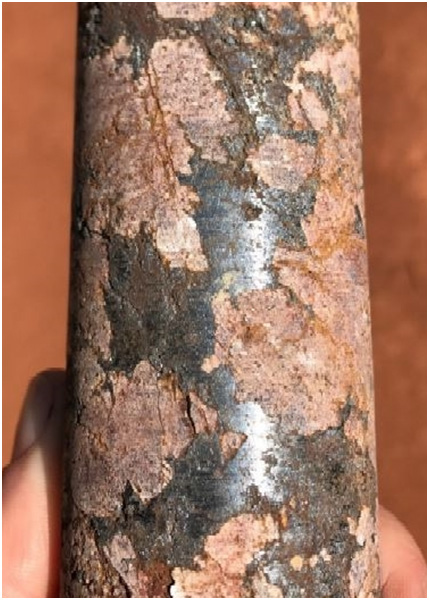
Improved copper recoveries and concentrate grades confirmed by preliminary metallurgical tests on drill core from Kakula
Following on from the positive preliminary test work results received during Q4 2016 of 87.8% recovery at an extremely high concentrate grade of 56% copper, the next phase of flowsheet development has been initiated.
A metallurgical drilling campaign to compile a representative composite sample has been completed and material is being prepared for shipment to the XPS metallurgical laboratories in Canada. This sample will be used for the PFS circuit development and optimization test work planned for the second half of 2017.
Earlier metallurgical test work indicated that the Kamoa and Kakula concentrates contain extremely low arsenic levels by world standards – approximately 0.02%. Given this critical competitive marketing advantage, Kamoa-Kakula concentrates are expected to attract a significant premium from copper-concentrate traders for use in blending with concentrates from other mines. The concentrates will help to enable the other concentrates to meet the limit of 0.5% arsenic imposed by Chinese smelters to meet China’s environmental restrictions.
Excavation underway on the Kakula box cut; decline development expected to begin in November
The contract for excavation of the Kakula box cut, support and civil works has been awarded to CREC 9, a Chinese company. The first blast for the excavation was successfully completed ahead of schedule on June 28, 2017. Work is scheduled for completion by the end of October 2017.
Tenders for the Kakula decline development were issued to potential contractors and their bids were received in June 2017. Adjudication and clarifications are well advanced and confirmation of the preferred contractor is expected shortly.
Figures 11 and 12: The first blast, followed by ongoing excavation work at the Kakula box cut.
Development at the Kansoko Mine has reached the high-grade copper mineralization
Byrnecut Underground Congo SARL progressed well with the decline development at the Kansoko Sud Mine during first six months of 2017. A total of more than 2,100 metres of development had been achieved at the end of June 2017. Byrnecut is expected to complete its contractual scope of approximately 2,500 metres in August 2017.
As at June 30, 2017, the service decline had advanced more than 925 metres and the conveyor decline more than 890 metres. Both declines passed through the lower diamictite in July and have entered the high-grade mineralization.
Figure 13: Copper ore from the Kansoko Mine now under development in the DRC saw daylight for the first time in July.
Kamoa mine site connected to the national hydroelectric grid
The construction of a 120 kilovolt (kV) power line was completed and a 120kV mobile substation installed, commissioned and energized in Q4 2016. The Kamoa mine site now is connected to the national electrical grid and is receiving hydropower for work on site. An eight-kilometre, 11kV overhead power line with mini-substations was constructed from the mine site to the Kamoa camp and is supplying hydropower to the Kamoa camp. Line routes for the 120kV power line and the 11kV reticulation to Kakula have been finalized and connection is expected before the end of the year.
Refurbishment work progressing at the Mwadingusha power station
The Mwadingusha Unit 1 repair work was completed in August 2016. The Mwadingusha G1 unit, supplying 11 megawatts, was synchronized in September 2016 to the national, interconnected grid operated by SNEL, the DRC’s state-owned power company. The contract to purchase four turbines for the Mwadingusha power plant upgrades was awarded and the contract signed between SNEL and the consortium Andritz Hydro & Cegelec Corporation. The Mwadingusha G1 and associated infrastructure upgrading is proceeding according to plan.
Continued focus on jobs, community and sustainability
The number of job opportunities from the Kamoa-Kakula Project and contractors has risen during the first half of 2017 due to the increase in activity around the camp and mine area. Preference is given to local job-seekers and numerous positions have been filled.
The Sustainable Livelihoods project is largely aimed at economically empowering communities in the vicinity of the planned mine. The project, which has been in place for the past five years, has continued to successfully manage the following programs during 2017 to date:
- a small-holder maize (corn) production program yielded maize from local communities as well as the mine’s farm, which now includes a recently acquired maize sheller, maize cleaning machine, dehuller and grinding mill for maize meal production;
- a vegetable program supplying produce to the Kamoa-Kakula Project camp kitchen;
- a poultry project that supplies the Kamoa-Kakula Project camp kitchen with chickens and eggs;
- a beekeeping program managing more than 50 honey-producing hives; and
- a fish-farming program, consisting of two fully-stocked dams, with a third dam under construction.
4. Western Foreland Exploration Project
100%-owned by Ivanhoe Mines
Democratic Republic of Congo
Exploration begins on Ivanhoe’s 100%-owned Western Foreland exploration licences west of Kamoa-Kakula
Ivanhoe Mines continues to hold an extensive land position in the Western Foreland region of the Central African Copperbelt that remains highly prospective for Kamoa-Kakula-type copper deposits. A $4 million budget has been allocated to restart exploration activities on the 100% Ivanhoe-owned licences situated to the west of the Kamoa-Kakula Project. Ivanhoe’s DRC exploration group initiated field exploration work earlier this month. The location of Ivanhoe’s Western Foreland exploration licences in relation to the Kamoa-Kakula Project is shown in Figure 14.
Figure 14: Ivanhoe’s 100%-owned Western Foreland exploration licences, west of the Kamoa-Kakula mining licence.
Selected quarterly financial information
The following table summarizes selected financial information for the prior eight quarters. Ivanhoe had no operating revenue in any financial reporting period and did not declare or pay any dividend or distribution in any financial reporting period.
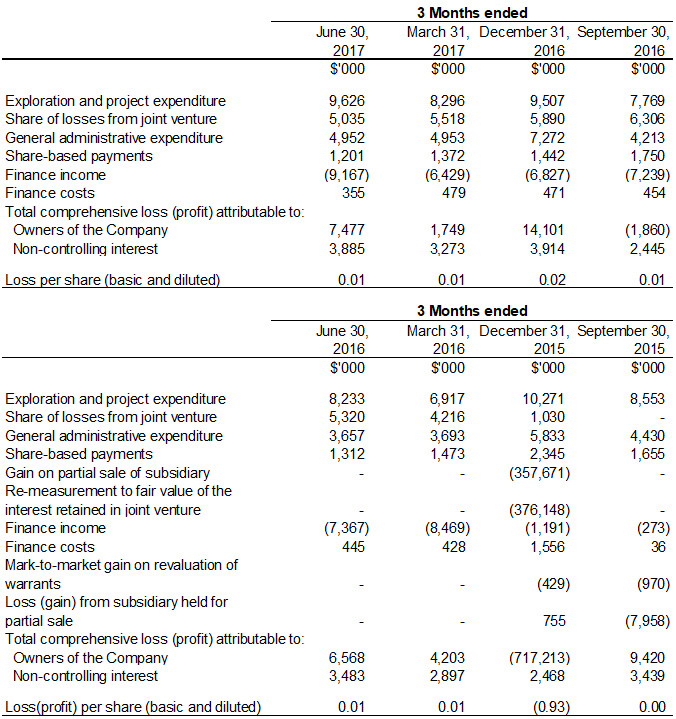
Discussion of results of operations
Review of the three months ended June 30, 2017, vs. June 30, 2016
The company’s total comprehensive loss for Q2 2017 of $11.4 million was $1.3 million higher than for the same period in 2016 ($10.1 million). The increase mainly was due to a loss of $1.8 million on the fair valuation of listed shares held by the company in Q2 2017 compared to a gain of $1.5 million in Q2 2016, which was included in other losses (income) in the condensed consolidated interim statements of comprehensive loss.
Exploration and project expenditures for the three months ending June 30, 2017, amounted to $9.6 million and were $1.4 million more than for the same period in 2016 ($8.2 million).
With the focus at the Platreef Project on development and the Kamoa Project being accounted for as a joint venture, $9.5 million of the total $9.6 million exploration and project expenditure related to the Kipushi Project. Expenditure at the Kipushi Project increased by $1.4 million compared to the same period in 2016. The main classes of expenditure at the Kipushi Project in Q2 2017 and Q2 2016 are set out in the following table:
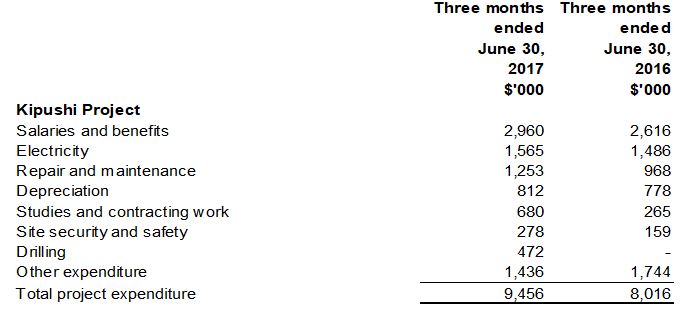
The company’s share of losses from the Kamoa Holding joint venture decreased from $5.3 million in Q2 2016 to $5.0 million in Q2 2017. The following table summarizes the company’s share of the comprehensive loss of Kamoa Holding for the three months ending June 30, 2017 and for the same period in 2016:
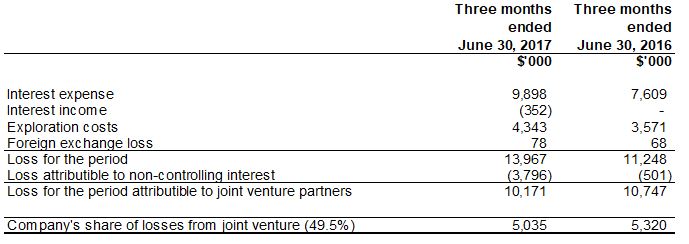
The costs associated with mine development are capitalized as development costs in Kamoa Holding, while the exploration expenditure is expensed. The interest expense in the Kamoa Holding joint venture relates to shareholder loans where each shareholder is required to fund Kamoa Holding in an amount equivalent to its proportionate shareholding interest. The company is advancing Crystal River’s portion on its behalf in return for an increase in the promissory note due to Ivanhoe.
Review of the six months ended June 30, 2017, vs. June 30, 2016
The company’s total comprehensive loss of $16.4 million for the six months ended June 30, 2017, was $0.8 million lower than for the same period in 2016 ($17.2 million).
The company’s share of losses from the Kamoa Holding joint venture increased to $10.6 million for the six months ended June 30, 2017, from $9.5 million for the same period in 2016. The following table summarizes the company’s share of the comprehensive loss of Kamoa Holding for the six months ending June 30, 2017, and for the same period in 2016:
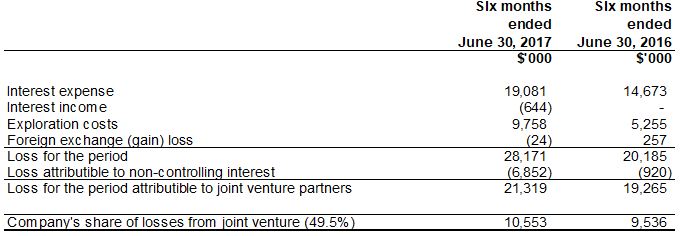
Exploration and project expenditures for the six months ending June 30, 2017, amounted to $17.9 million and were $2.8 million less than for the same period in 2016 ($15.2 million). Of the $17.9 million exploration and project expenditure, $17.6 million related to the Kipushi Project.
Expenditure at the Kipushi Project increased by $2.9 million compared to the same period in 2016. The main classes of expenditure at the Kipushi Project for the six months ending June 30, 2017, and 2016 are set out in the following table:
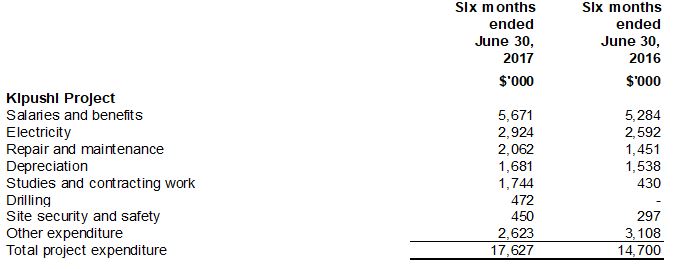
Financial position as at June 30, 2017 vs. December 31, 2016
The company’s total assets decreased by $12.0 million, from $1,002.2 million as at December 31, 2016, to $990.2 million as at June 30, 2017. This resulted from the company utilizing its cash resources in its operations. The company’s total liabilities decreased by $1.8 million to $44.2 million as at June 30, 2017, from $46.0 million as at December 31, 2016.
The company received the fourth installment of $41.2 million on February 8, 2017, and the fifth and final installment on May 23, 2017, which represented the remaining purchase price receivable due to the company as at December 31, 2016, as a result of the sale of 49.5% of Kamoa Holding.
The company’s investment in the Kamoa Holding joint venture increased by $35.6 million from $473.6 as at December 31, 2016, to $509.2 million as at June 30, 2017, with the current shareholders funding the operations equivalent to their proportionate shareholding interest. The company’s portion of the Kamoa Holding joint venture cash calls amounted to $33.8 million during the six months ended June 30, 2017, while the company’s share of comprehensive loss from joint venture amounted to $10.6 million. At Kamoa-Kakula, development at Kansoko continued, together with an exploration program; while development commenced at Kakula with the start of the Kakula box cut.
Property, plant and equipment increased by $25.9 million, with a total of $20.9 million being spent on project development and to acquire other property, plant and equipment, $19.4 million of which pertained to development costs of the Platreef Project.
The company utilized $21.9 million of its cash resources in its operations and earned interest income of $1.7 million during the six months ending June 30, 2017.
Liquidity and capital resources
The company had $287.0 million in cash and cash equivalents as at June 30, 2017. At this date, the company had consolidated working capital of approximately $294.6 million, compared to $364.8 million at December 31, 2016. The Platreef Project’s restricted cash has been fully utilized and the project’s current expenditure is being funded by Ivanhoe through an intercompany loan. The company believes it has sufficient resources to cover its short-term cash requirements. However, the company’s access to financing always is uncertain and there can be no assurance that additional funding will be available to the company in the near future.
On December 8, 2015, Zijin, through a subsidiary company, acquired a 49.5% interest in Kamoa Holding for a total of $412 million in a series of payments. Ivanhoe received an initial $206 million from Zijin on December 8, 2015, and a further $41.2 million on each of March 23, 2016, July 8, 2016, October 25, 2016, February 8, 2017, and May 23, 2017. Since December 8, 2015, each shareholder in Kamoa Holding has been required to fund Kamoa Holding in an amount equivalent to its proportionate shareholding interest. The company is advancing Crystal River’s portion on its behalf in return for an increase in the promissory note due to Ivanhoe.
The company’s main objectives for the remainder of 2017 at the Platreef Project are the continuation of Shaft 1 construction and early-works construction of Shaft 2. At Kipushi, the principal objective is the completion of the PFS and continued upgrading of mining infrastructure. At the Kamoa-Kakula Project, priorities are the continuation of drilling, the continuation of construction of the twin declines at Kamoa, the construction of a box cut at Kakula and the commencement of decline construction at Kakula. The company expects to spend $44 million on further development at the Platreef Project; $30 million at the Kipushi Project; $4 million on regional exploration in the DRC; and $8 million on corporate overheads for the remainder of 2017 – as well as its proportionate funding of the Kamoa-Kakula Project, expected to be $45 million for the remainder of 2017.
Qualified Person
Disclosures of a scientific or technical nature in this news release have been reviewed and approved by Stephen Torr, who is considered, by virtue of his education, experience and professional association, a Qualified Person under the terms of NI 43-101. Mr. Torr is not considered independent under NI 43-101 as he is the Vice President, Project Geology and Evaluation. Mr. Torr has verified the technical data disclosed in this news release.
Ivanhoe had prepared a current independent NI 43-101-compliant technical report for each of the Platreef Project, the Kipushi Project and the Kamoa-Kakula Project, which are available under the company’s SEDAR profile at www.sedar.com:
- Technical Report dated January 20, 2017, prepared by OreWin Pty. Ltd., Amec Foster Wheeler and SRK Consulting Inc. covering the company’s Kamoa-Kakula Project.
- Technical Report dated April 22, 2016, prepared by OreWin Pty. Ltd., Amec Foster Wheeler, Stantec Inc., SRK Consulting Inc. and DRA Projects (Pty.) Ltd. covering the company’s Platreef Project.
- Technical Report dated March 11, 2016, prepared by MSA Group (Pty) Ltd and OreWin Pty. Ltd., covering the company’s Kipushi Project.
These technical reports include relevant information regarding the effective dates and the assumptions, parameters and methods of the mineral resource estimates for the Platreef Project, the Kipushi Project and the Kamoa-Kakula Project cited in this news release, as well as information regarding data verification, exploration procedures and other matters relevant to the scientific and technical disclosure contained in this news release in respect of the Platreef Project, Kipushi Project and Kamoa-Kakula Project.
Additional Information
This news release should be read in conjunction with Ivanhoe Mines’ Q2 2017 Financial Statements and Management’s Discussion and Analysis report available at www.ivanhoemines.com and at www.sedar.com.
Additional information regarding the company, including the company’s Annual Information Form, is available at www.sedar.com.
Information contacts
| Investors Bill Trenaman +1.604.331.9834Website www.ivanhoemines.com |
Media North America: Bob Williamson +1.604.512.4856 South Africa: Jeremy Michaels +27.82.088.4300 |
Forward-looking statements
Certain statements in this release constitute “forward-looking statements” or “forward-looking information” within the meaning of applicable securities laws. Such statements and information involve known and unknown risks, uncertainties and other factors that may cause the actual results, performance or achievements of the company, its projects, or industry results, to be materially different from any future results, performance or achievements expressed or implied by such forward-looking statements or information. Such statements can be identified by the use of words such as “may”, “would”, “could”, “will”, “intend”, “expect”, “believe”, “plan”, “anticipate”, “estimate”, “scheduled”, “forecast”, “predict” and other similar terminology, or state that certain actions, events or results “may”, “could”, “would”, “might” or “will” be taken, occur or be achieved. These statements reflect the company’s current expectations regarding future events, performance and results and speak only as of the date of this release.
Such statements include without limitation, the timing and results of: (i) statements regarding Shaft 1 providing initial access for early underground development at the Flatreef Deposit; (ii) statements regarding the station development of Shaft 1 at the 450-, 750-, 850- and 950-metre levels; (iii) statements regarding the sinking of Shaft 1, including that a sinking rate of 45 metres per month is expected; (iv) statements regarding Shaft 1 reaching the planned, final depth at 980 metres below surface in 2018; (v) statements regarding the timing of the commencement of Shaft 2 development, including that construction will take approximately 12 months to complete and will be sunk to a final depth of more than 1,100 metres; (vi) statements regarding the operational and technical capacity of Shaft 1; (vii) statements regarding the internal diameter and hoisting capacity of Shaft 2; (viii) statements regarding the company’s plans to develop the Platreef Mine in three phases: an initial annual rate of four million tonnes per annum (Mtpa) to establish an operating platform to support future expansions; followed by a doubling of production to eight Mtpa; and then a third expansion phase to a steady-state 12 Mtpa; (ix) statements regarding the planned underground mining methods of the Platreef Project including long-hole stoping and drift-and-fill mining; (x) statements regarding peak water use of 7.5 million litres per day at the Platreef Project and development of the Pruissen Pipeline Project; (xi) statements regarding the Platreef Project’s estimated electricity requirement of 100 million volt-amperes; (xii) statements regarding the timing and completion of an updated preliminary economic assessment at the Kamoa-Kakula Project in Q3 2017 and a preliminary feasibility study for a six Mtpa mine at Kakula; (xiii) statements regarding the timing, size and objectives of drilling and other exploration programs for 2017 and future periods, including drilling of 129,000 metres at Kakula West in 2017 and 6,500 metres at the Kipushi Project in 2017; (xiv) statements regarding initiating of field exploration and testing on the Western Foreland exploration licences in Q3 2017;(xv) statements regarding decline development at Kakula being expected to begin in November 2017; (xvi) statements that the completion of the Kakula box-cut excavation being completed by the end of October, 2017; (xvii) statements regarding the timing of an initial resource estimate at Kakula West, and (xviii) statements regarding expected expenditure for the remainder of 2017 of $44 million on further development at the Platreef Project; $30 million at the Kipushi Project; $4 million on regional exploration in the DRC; and $8 million on corporate overheads – as well as its proportionate funding of the Kamoa-Kakula Project, expected to be $45 million for the remainder of 2017.
As well, all of the results of the pre-feasibility study of the Kamoa-Kakula Project and preliminary economic assessment of development options for the Kakula deposit, the feasibility study of the Platreef Project and the preliminary economic assessment of the Kipushi Project, constitute forward-looking statements or information, and include future estimates of internal rates of return, net present value, future production, estimates of cash cost, proposed mining plans and methods, mine life estimates, cash flow forecasts, metal recoveries, estimates of capital and operating costs and the size and timing of phased development of the projects. Furthermore, with respect to this specific forward-looking information concerning the development of the Kamoa-Kakula, Platreef and Kipushi projects, the company has based its assumptions and analysis on certain factors that are inherently uncertain. Uncertainties include: (i) the adequacy of infrastructure; (ii) geological characteristics; (iii) metallurgical characteristics of the mineralization; (iv) the ability to develop adequate processing capacity; (v) the price of copper, nickel, zinc, platinum, palladium, rhodium and gold; (vi) the availability of equipment and facilities necessary to complete development; (vii) the cost of consumables and mining and processing equipment; (viii) unforeseen technological and engineering problems; (ix) accidents or acts of sabotage or terrorism; (x) currency fluctuations; (xi) changes in regulations; (xii) the compliance by joint venture partners with terms of agreements, (xiii) the availability and productivity of skilled labour; (xiv) the regulation of the mining industry by various governmental agencies; and (xiv) political factors.
This release also contains references to estimates of Mineral Resources and Mineral Reserves. The estimation of Mineral Resources is inherently uncertain and involves subjective judgments about many relevant factors. Estimates of Mineral Reserves provide more certainty but still involve similar subjective judgements. Mineral Resources that are not Mineral Reserves do not have demonstrated economic viability. The accuracy of any such estimates is a function of the quantity and quality of available data, and of the assumptions made and judgments used in engineering and geological interpretation (including estimated future production from the company’s projects, the anticipated tonnages and grades that will be mined and the estimated level of recovery that will be realized), which may prove to be unreliable and depend, to a certain extent, upon the analysis of drilling results and statistical inferences that ultimately may prove to be inaccurate. Mineral Resource or Mineral Reserve estimates may have to be re-estimated based on: (i) fluctuations in copper, nickel, zinc, platinum group elements (PGE), gold or other mineral prices; (ii) results of drilling; (iii) metallurgical testing and other studies; (iv) proposed mining operations, including dilution; (v) the evaluation of mine plans subsequent to the date of any estimates and/or changes in mine plans; (vi) the possible failure to receive required permits, approvals and licences; and (vii) changes in law or regulation.
Forward-looking statements and information involve significant risks and uncertainties, should not be read as guarantees of future performance or results and will not necessarily be accurate indicators of whether or not such results will be achieved. A number of factors could cause actual results to differ materially from the results discussed in the forward-looking statements or information, including, but not limited to, the factors discussed below and under “Risk Factors”, as well as unexpected changes in laws, rules or regulations, or their enforcement by applicable authorities; the failure of parties to contracts with the company to perform as agreed; social or labour unrest; changes in commodity prices; and the failure of exploration programs or studies to deliver anticipated results or results that would justify and support continued exploration, studies, development or operations.
Although the forward-looking statements contained in this release are based upon what management of the company believes are reasonable assumptions, the company cannot assure investors that actual results will be consistent with these forward-looking statements. These forward-looking statements are made as of the date of this release and are expressly qualified in their entirety by this cautionary statement. Subject to applicable securities laws, the company does not assume any obligation to update or revise the forward-looking statements contained herein to reflect events or circumstances occurring after the date of this release.
The company’s actual results could differ materially from those anticipated in these forward-looking statements as a result of the factors set forth in the “Risk Factors” section of the company’s Q2 2017 MD&A and its Annual Information Form.


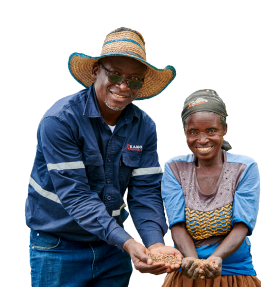
 English
English Français
Français 日本語
日本語 中文
中文